Save $40 on your initial consult with a TNI Dietitian!
Talk to a real Dietitian for only $99: Schedule Now
This post contains links through which we may earn a small commission should you make a purchase from a brand. This in no way affects our ability to objectively critique the products and brands we review.
Evidence Based Research To fulfill our commitment to bringing our audience accurate and insightful content, our expert writers and medical reviewers rely on carefully curated research.
Read Our Editorial Policy
Whether you’re a wine connoisseur turned sober socialite or just looking for new beverages to spice up your alcohol-free lifestyle, we’ve got the best-tasting wines for you to try in this list.
In another life not so long ago, I was a wine educator and server at a well-to-do sustainable winery and vineyard on the central coast of California.
With this experience in mind and my deep love and appreciation for the art of winemaking (I know, pretentious much?), my expectations for non-alcoholic wine were, let’s say, subdued…
Regardless, I was very open-minded and excited to find a healthier alternative to a beverage with which I have a love-hate relationship: the love being the artistry of wine, the science behind how it’s made, and the taste.
The hate, on the other hand? Ugh, how my head pounds after a couple of glasses of the stuff. I just can’t drink it regularly anymore! So, without further ado, let’s get into it.
Best Non-Alcoholic Wine to Enjoy On-the-Go: Surely Non-Alcoholic Brut
Best Non-Alcoholic Wine Overall: Château del ISH Non-Alcoholic Sparkling Espumante
Best Non-Alcoholic Dry Sparkling Wine: Oddbird Blanc de Blancs Sparkling Non-Alcoholic Wine
Best Non-Alcoholic White Wine: Studio Null Grüner Weiss
Most Sustainable Non-Alcoholic White Wine: Noughty Non-Alcoholic Blanc
The Nutrition Insider prides itself on being a neutral third party that only reviews products we believe in. Our team comprises doctors, registered dietitians, and food experts dedicated to providing you with the best science-backed takes on the latest food, supplement, nutrition trends, and health products.
Our content dives deeper than surface-level branding and marketing claims, providing value-added “industry insider” information. For more information about how The Nutrition Insider conducts its reviews and other aspects of our business, please feel free to read our Editorial Policy.
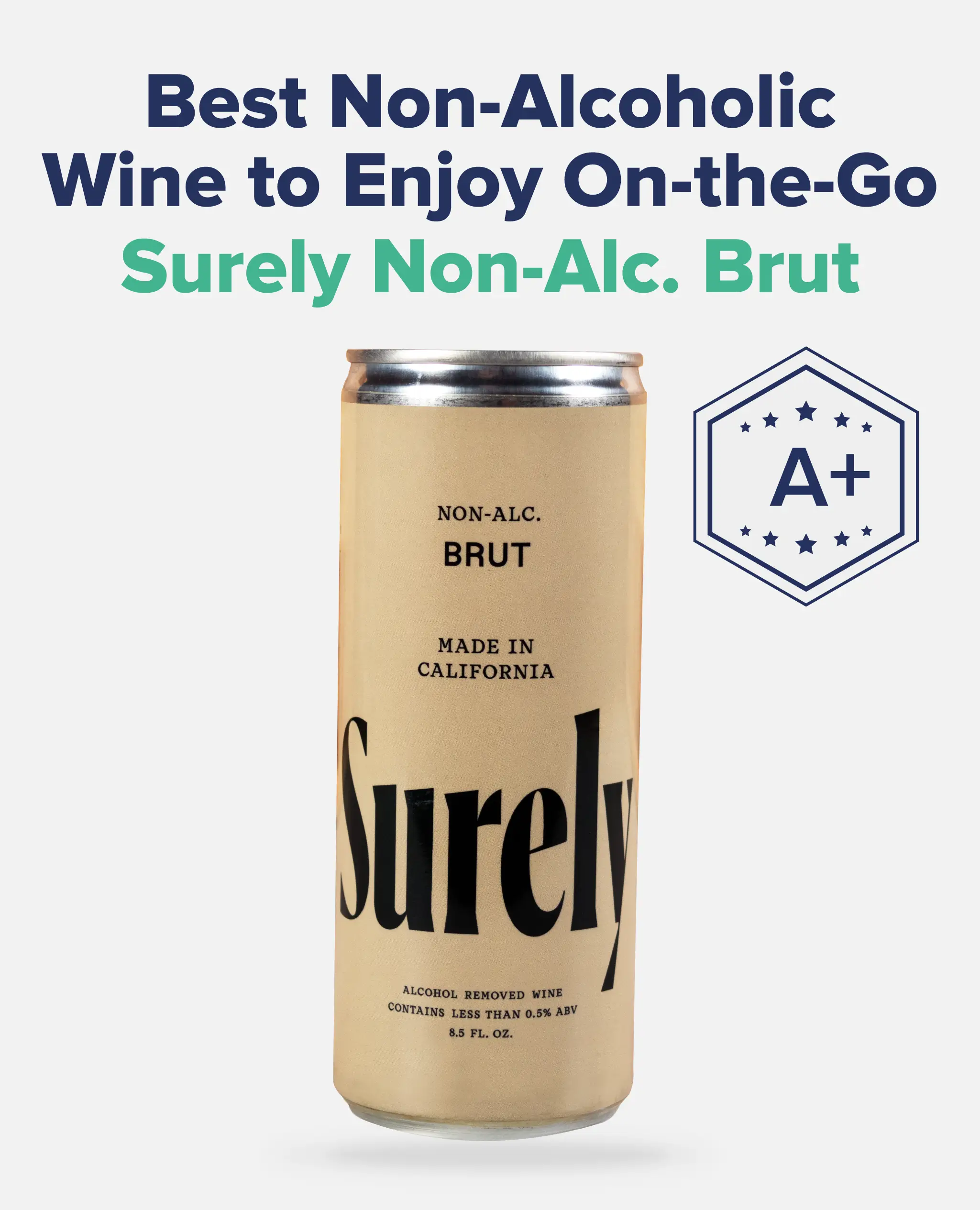
Stick with me on this one… Surely is to White Claw as an upscale garden party is to a backyard barbecue, or a classic novel is to a summer beach read.
Besides one being alcoholic and the other alcohol-free, sure, each has its pros and cons and reasons for cracking open on a warm summer day or a casual sip on the couch on a cold winter evening.
One thing you won’t miss from White Claws, though, is the raging hangovers the next day. Surely, on the other hand, is guaranteed to keep you satiated, sober, and still feeling like you’re part of the fun.
Surely produces several different wine products, including cans and bottles. For the purposes of this review, we only tested Surely’s canned Non-Alcoholic Brut. However, Surely also sells a sparkling rosé and bubbly red.
Here are all of their canned products, which are all very highly reviewed and recommended:
Ingredients include the following for each: (Brut) Dealcoholized White Wine, Guava Concentrate, Grapefruit Juice, Cane Sugar, Sulfites (preservative); (Rosé) De-alcoholized California Rosé Wine, Guava Concentrate, Grapefruit Juice, Acacia Gum, Sulfites (Preservative); (Bubbly Red) De-alcoholized Red Wine Blend, Water, Cherry Concentrate, White Grape Concentrate, Natural Flavors, Carbon Dioxide, Sulfites (preservative).
Green flags all around here! Each flavor contains a limited number of naturally occurring ingredients and additives.
A quick note about sulfites: Sulfites get a bad rap, but many consumers don’t realize that they often naturally occur in the winemaking process or are added to preserve the wine. Without sulfites, wine would spoil very easily and quickly! The only people who need to be concerned about sulfites are those who are allergic to them and experience reactions when drinking beverages containing them.
The nutritional value of each of these flavors is also great, especially in comparison to alcoholic canned wines. This is especially true about the sugar content, which is very low for a non-diet beverage!
Below, I’ve listed the nutritional values for each can as a range for the macronutrients and sugars.
Nutrition facts per serving (1 8.5 fl oz can):
While you won’t get any health benefits from these canned non-alcoholic wines, you won’t stack up empty calories or high amounts of sugar and suffer from the health impacts of alcohol. Win-win-win!
Yes, the nutritional value and ingredient profile are important, but if something doesn’t taste good, what’s the point of drinking it, right?
Well, that’s been an issue plaguing the non-alcoholic beverage industry for some time now. However, Surely is joining the ranks of many NA beverage companies that are cleverly perfecting the flavor profile of some of our favorite alcoholic beverages.
These canned sparkling non-alcoholic wines are a great substitute for other canned wine beverages in taste and texture. They are sweet but not cloyingly so, and they have that fizzy, buzzy bite you get from a regular sparkling wine. I personally found them very enjoyable!
There’s no getting around the price for a 4-pack of these wines. At $24.99, this comes out to about $6.25 per can.
So, if you’re bringing these with you to the kickback so you have some not-so-obvious non-alcoholic options on hand, you’re probably not going to want to share with your buds.
To play devil’s advocate, I want to mention two factors to consider in the pricing.
One: A typical serving of sparkling wine is about 4oz. So, with 8.5oz per can, one could argue that you’re getting more than the equivalent of 2 servings per can.
Two: In theory, the pricing is fair since the product is not only made the same way as wine (you still have to grow the grapes, harvest, and ferment them), but it also has to undergo an additional de-alcoholization process. This adds time and labor to the production process, thus increasing the cost of the final product.
This is something good to keep in mind when considering the cost of any processed good, but especially the cost of non-alcoholic wine products.
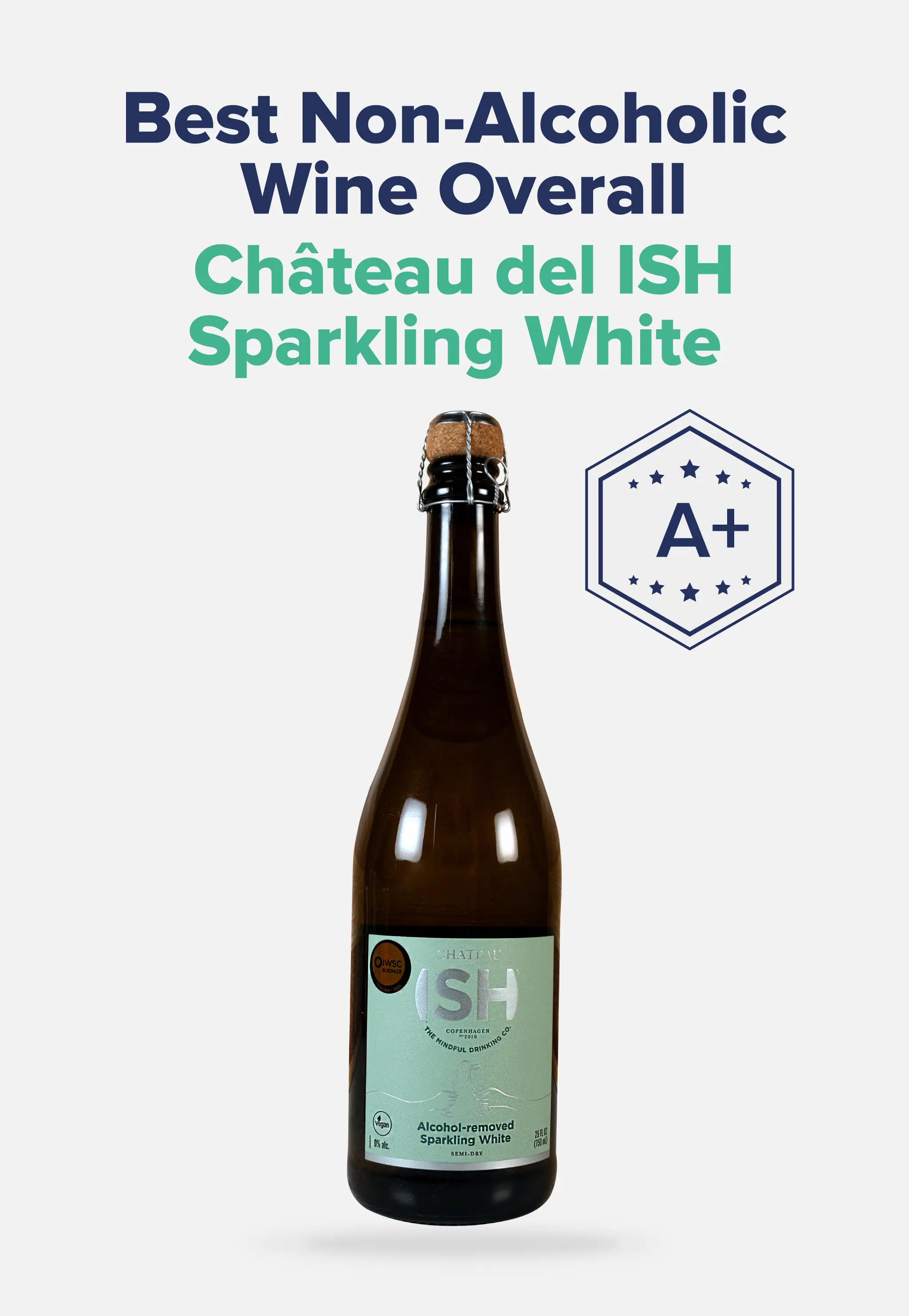
Moving from the rolling hills of coastal California to the beautiful arid countryside of Spain, we have Château del ISH, which produces a non-alcoholic sparkling white and rosé wine.
These bottles flawlessly deliver in taste and texture and give me all the warm fuzzies I’m used to when drinking sparkling wine but without the buzz.
While it earns an A+ for taste, it scores just slightly lower than our top picks (by one point) since one of its wines includes “natural flavors” and glycerol, a type of sugar alcohol.
These ingredients are entirely safe to consume in moderation. However, sometimes sugar alcohols can cause stomach upset. Hence it’s been marked as a point of concern.
Chateau del ISH follows the “less is more” approach, producing just three non-alcoholic wine products: a sparkling rosé, a sparkling white wine, and an espumante.
Each of these wines earned a Silver award from USA Wine Ratings in 2023, and their White and Rosé were awarded silver and bronze commendations from Global Wine Masters, Bartenders Brand Awards, and the International Wine & Spirit Competition (IWSC). Quite the collection!
Ingredients for the white and rosé include alcohol-removed wine, grape must, rectified concentrated grape must, carbon dioxide, and preservative: sulfites.
On the other hand, the ingredients for the espumante are a bit different: De-alcoholized wine, water, grape must from concentrate, carbon dioxide, stabilizer: glycerol (E422), natural flavoring, preservative: potassium metabisulfite (E224).
For the most part, I wouldn’t be too worried about glycerol and natural flavoring if consumed in moderation. Glycerol is a type of stabilizer that can be used to preserve or sweeten products, but in large amounts (more than you could drink in one sitting, mind you), it can upset your digestive system.
Typically, we don’t like to see natural flavorings on ingredient lists since they could be derived from various fruits, vegetables, spices, herbs, and bark. This can pose a risk for those with severe allergies.
Additionally, natural flavors like those derived from grapefruit can use synthetic chemicals like propylene glycol and still be labeled as “natural.” This isn’t a huge concern for moderate consumption, but it’s still something we think brands should be more transparent about.
Nutrition facts per serving (100ml):
The experience of opening and consuming both the Rosé and Espumante was lovely.
The bottle feels like the real thing. When poured, the wine bubbles up just like a typical champagne or prosecco. While drinking them, I enjoyed the same fizzy sensation and subtly sweet flavor I adore so much in classic sparkling wines.
If you’re looking for a bottle to share with your other sober friends, this is the perfect crowd-pleaser.
The Zero Proof sells Château del ISH’s Sparkling White and Rosé for $24.99 and their Espumante for $18.99.
In my opinion, these prices are fair and comparable for a low- to mid-range classic sparkling wine.
Again, as noted in the previous review, non-alcoholic wine undergoes the same winemaking process as regular wine with the addition of dealcoholization. The ingredients, processing, and labor involved will factor into the price.
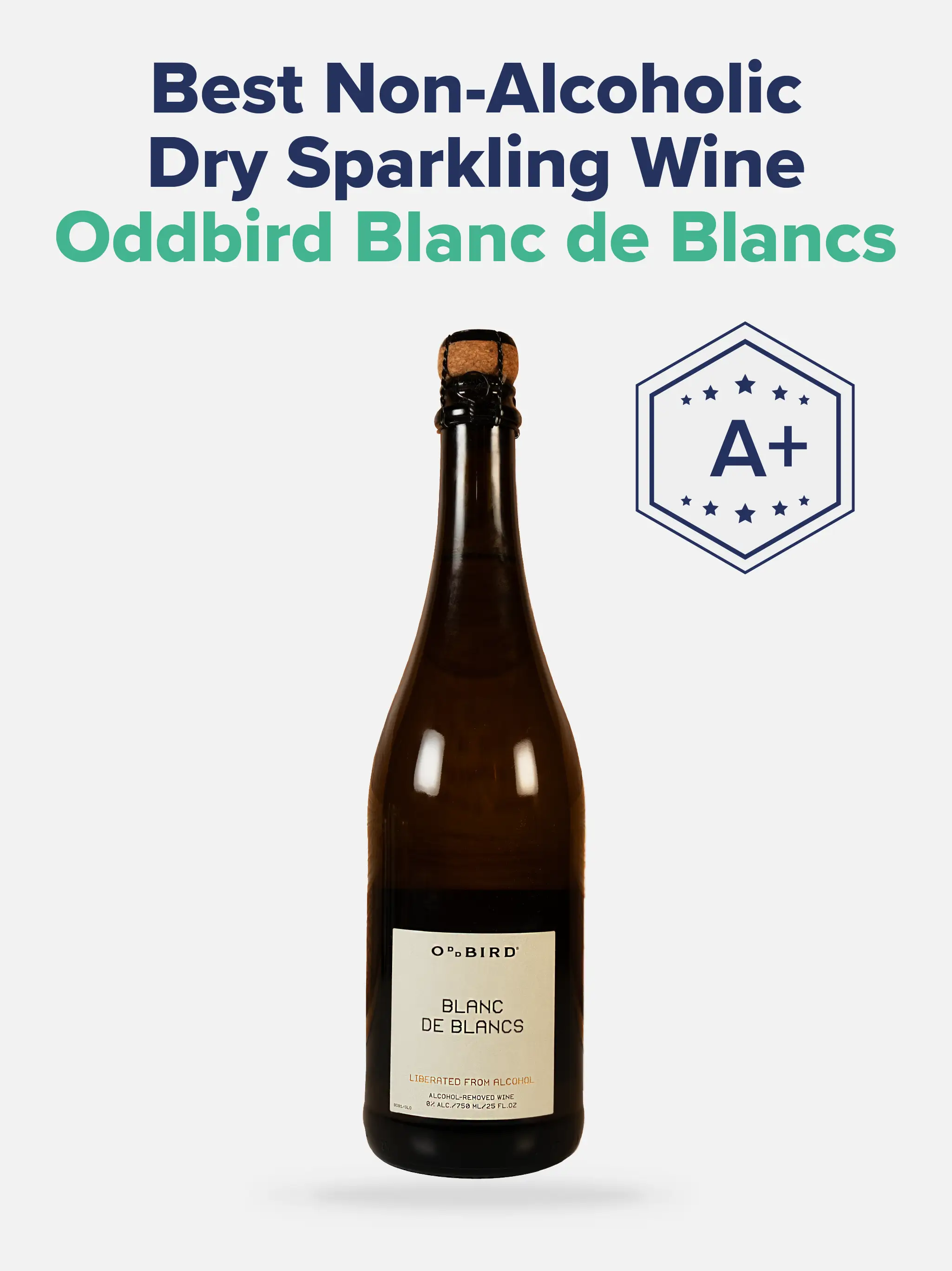
This is it. This is the non-alcoholic wine you bring as a gift to your sober friends and family, especially those who used to love drinking wine.
As a quick aside, I enjoyed the flavor of this wine so much that I think it might be worth asking the person you intend to gift this to if they are okay with drinking non-alcoholic beverages that mimic those same flavors.
We learned earlier this year from the founder of Mingle Mocktails, Laura Taylor, that sometimes drinks that mimic alcohol can be triggering. Only ask if you have a close relationship with them and feel comfortable doing so, but it might be worth it to avoid causing unintended discomfort.
Suffice it to say this wine does a fabulous job of mimicking the sensation and flavors of sparkling wine. I would drink this if I were pursuing a more serious period of sobriety or just wanted to pace myself with an in-between drink during dinner.
One thing I find Oddbird does really well is still instilling the art and science of winemaking into their brand story.
They aren’t just making non-alcoholic wine to fill a market gap; they’re creating quality non-alcoholic wine that wine lovers would genuinely enjoy and that you could appreciate in the same way as regular wine.
You can swirl, smell, taste, and roll this wine around on your tongue. Yes, you’ll know it isn’t real wine, but you won’t feel like you’re just drinking glorified grape juice you paid 25 bucks for.
Thanks to this novel approach to non-alcoholic winemaking, the ingredients are similar to those on the back of a real bottle of wine (that is, if they had ingredient lists).
This includes just four ingredients: De-alcoholized wine, sugar, carbon dioxide, and preservatives (sulfites).
Nothing here looks out of the ordinary, and I have no concerns about their quality either.
We have only tried the Blanc de Blancs, but Oddbird currently sells 13 wines! Here are just a few wines from their collection for you to explore:
From start to finish, you can tell that Oddbird put care into crafting a great bottle of non-alcoholic wine.
The dark, opaque bottle paired with the simplistic label makes for an elegant gift-worthy bottle of wine. As you can probably gather from the start of my review, the taste is top-notch and on par with very light sparkling wines (dryer and less sweet). So, if that’s your jam, this is your wine.
As a side note, there was a slight issue when opening the bottle—the cork popped off as soon as the cage was loosened. This can happen to any sparkling wine so I can’t say it was a producer or distributor issue, but it’s a good reminder always to point sparkling wines away from you when opening them!
This wine is priced at $24.99 on The Zero Proof, which is comparable to other non-alcoholic wines.
Other Oddbird wines top out at $31, and canned wines go for $6.99 each.
This is very fair for the quality you’re getting, and, dare I say it, I could see the price increasing in the future as the non-alcoholic wine market grows and demand increases.
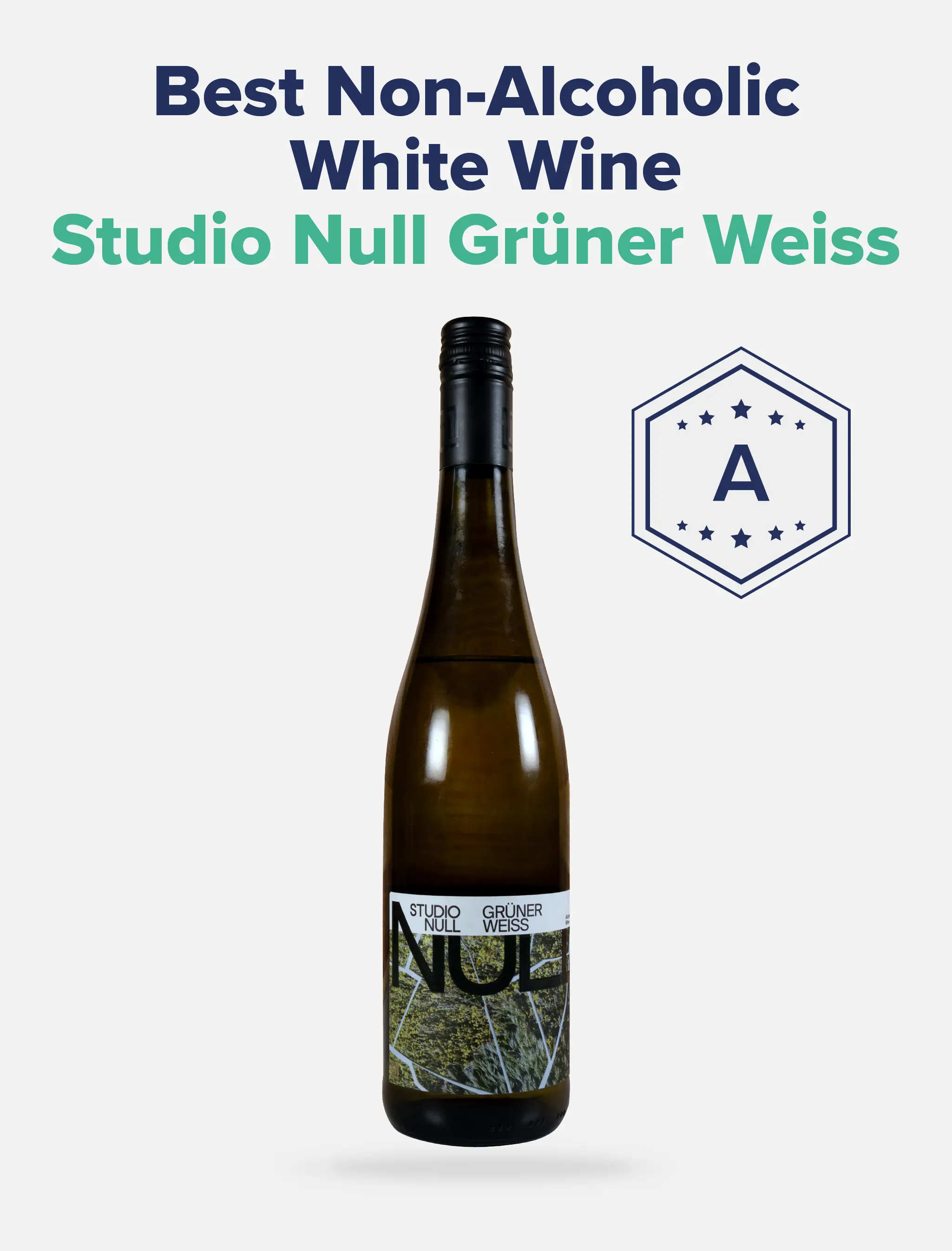
Besides the wine being gosh darn good, the branding here definitely feels like it was made with a younger crowd in mind. Just holding this bottle in my hand makes me feel like I’m on my way to a cool party hosted in some artsy fartsy loft in Berlin or SoHo.
Not that I would be let in, with or without the wine, but a girl can dream! And hey, at least I can drink on the sidewalk with this one.
Jokes aside, I love what Studio Null has done here: using traditional winemaking to make a consummately untraditional product with all the characteristics of real wine minus the alcohol.
I still think they have a bit of room to grow with exacting the flavor of their red wine, The Prickly Red, which is where it lost points. However, their Grüner Weiss is dangerously drinkable.
Like some of the other great wines on this list, Studio Null keeps its ingredients nice and tidy: de-alcoholized wine, sugar, carbon dioxide, and sulfur dioxide (a preservative).
Their grapes for the Grüner Weiss are sourced from a certified sustainable vineyard in Austria, and their Prickly Red receives Tempranillo and Syrah grapes directly from a vineyard in Murcia, Spain, that also uses sustainable growing methods.
The nutrition facts for both wines are fairly similar (1 serving 150ml)
This is pretty on par with other wines in this list. The primary difference is the added sugars, which are usually naturally occurring in other wines. However, 4 grams is a pretty negligible amount to be concerned about.
As mentioned above, I did enjoy both of these wines. However, the winner was definitely their white, the Grüner Weiss, over the red, the Prickly Red.
The white wine was so delicate and light-bodied that it really made it a treat to enjoy. I could definitely see myself sipping on this with friends while noshing on some fancy cheese and cured meats.
The Prickly Red fell short in a way I can’t describe. It wasn’t bad by any means, but it wasn’t appealing to me in a way that made me want to drink more than a glass. I’m sad to say.
However, I could easily see others enjoying this. It just wasn’t my cup of tea.
I would be curious to try their other wines when they make more batches in the future, but they currently only sell these two. In the past, they’ve sold a Sparkling Verdejo, a Sparkling Rosé, and a Solo Granacha; all sound delightful!
Coming in at $32 a piece, these wines are the priciest of the bunch. However, I still find this fair since, as I’ve mentioned elsewhere, you’re paying for a lot more than the grapes when it comes to the value of non-alcoholic wines.
These prices are quite low to compensate for the relatively low demand for non-alcoholic beverages, particularly wine. I anticipate that prices will increase in the near future as people discover more great brands like Studio Null.
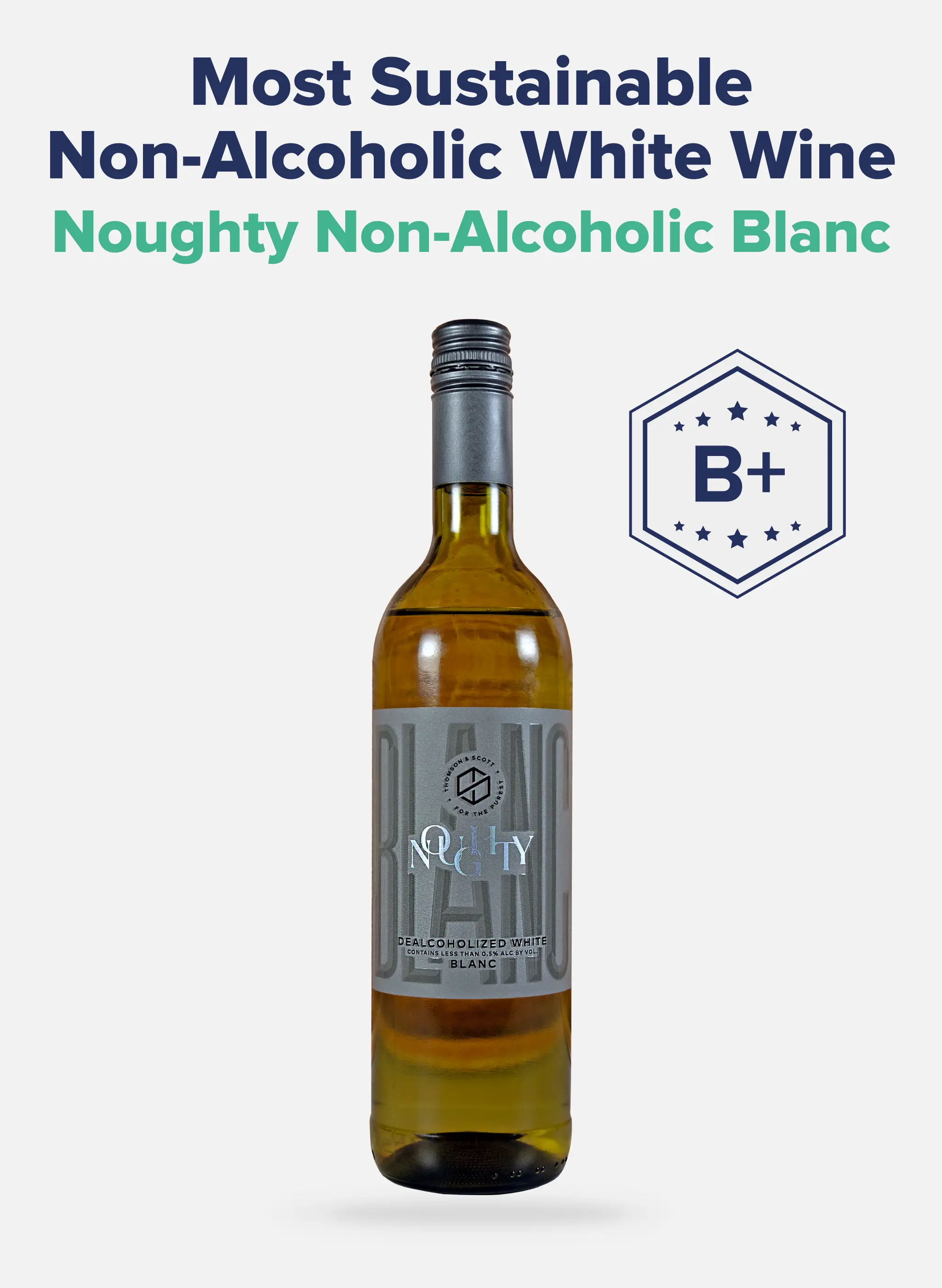
Right off the bat, I love how the name of this brand seemingly pokes a bit of fun at the fact that it’s a wine without the very thing that would make it, well, naughty.
In addition to cutting out the alcohol, this is one of the only brands on this list that is a Certified B Corporation, uses 100% organic grapes, and makes good sustainability efforts to offset its footprint.
Major props there! I love to see a healthy brand that is committed to sustainability.
However, I was concerned that the ingredients and nutrition facts were not listed, as you would find on the labels of other bottles of non-alcoholic beverages.
This is the sole reason Noughty lost points. Otherwise, it was 10s across the board, with an additional score added thanks to their sustainability efforts, which no other brand on this list, save Studio Null, could claim.
Like “real” wine, as mentioned, Noughty’s wines have no itemized ingredient list or nutrition facts.
Here is all the information I could find as listed on their website:
I’m not entirely sure why this product is excluded from this requirement, which so many other non-alcoholic products adhere to and is pretty strictly regulated by the FDA.
Without more information provided by Noughty themselves, we can only speculate, which I will not do here.
Instead, I’ll share more information about their grapes and the production process, which is a pretty exciting addition that many other non-alcoholic winemakers don’t bother with.
Noughty’s Dealcoholized Blanc is made with 55% Chenin Blanc and 45% Chardonnay grapes grown and harvested from dry-land farmed vineyards in South Africa’s Western Cape region.
Fun fact: dryland farming is a highly sustainable method for grape growing since it relies on rain to water the crops instead of irrigation. This can be tricky to manage when there is drought or unexpected lengthy periods without rain, but overall, it is an added benefit for the land and local water tables.
Once harvested, the grapes are fermented for 14 days and left “on the lees” (aged) for two months in its aging vessel. The wine is then dealcoholized using a spinning cone technology, done under vacuum and at low temperatures to preserve the wine’s flavor and body.
This wine was quite palatable! Even without being chilled beforehand, it had a great nose (it smelled good, in wine speak) and flavor to it.
I prefer very light wines, so this bottle appealed to me quite a lot. However, be warned: If you like bold white wines, this may not be the one for you.
That said, I live by the motto “less is more.” That’s why I gave this wine such a good score in the taste and mouthfeel department.
Again, this wine is priced at $24.99, almost exactly the same as most other non-alcoholic wines on this list and on the market.
I think it’s great that they can sell it at this price, considering the extra effort that goes into using more sustainable growing methods and the fact that this comes all the way from South Africa.
Here at The Nutrition Insider, we utilize bespoke selection and testing criteria to help us find products that we believe are the best the market has to offer.
Some of these products are from our trusted brands, which we have reviewed in the past and can subsequently count on to offer high-quality products.
Others we’ve found in an extensive search using good old-fashioned search engine sleuthing, perusing internet forums, and consulting consumer reviews.
For each product category, we utilize unique rubrics that contain product attributes graded on a 0-100 scale. This number is then turned into a letter grade, which we feel is a more quickly digestible metric for readers.
For the food and beverage category, I based my grades on the following attributes:
Non-alcoholic wine can be a better choice for those who want to enjoy the taste of wine without the effects of alcohol. It is generally lower in calories and eliminates the risks associated with alcohol consumption, such as impaired judgment, liver damage, and the potential for addiction.
Drinking alcohol-free wine every day is generally considered safe. It doesn’t carry the risks associated with alcohol consumption. However, as with any beverage, moderation is key. Non-alcoholic wine can contain added sugars and other additives, so it’s important to check the label if you’re concerned about your sugar intake or other ingredients.
Non-alcoholic wine should be refrigerated after opening to maintain its quality and freshness, just like regular wine. Before opening, it can typically be stored in a cool, dark place. Once opened, refrigeration helps prevent spoilage and preserves the flavor. As with regular wine, consume it within a few days after opening for the best taste.